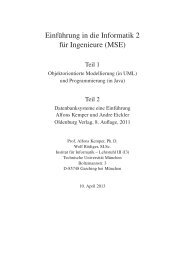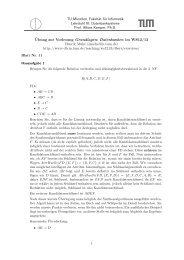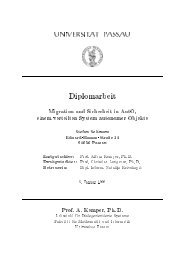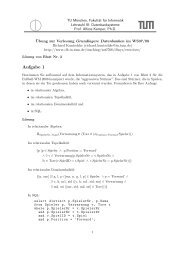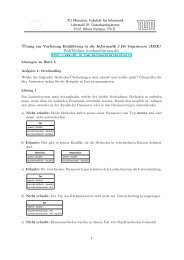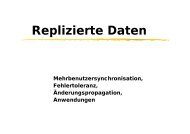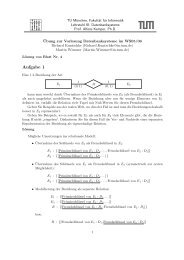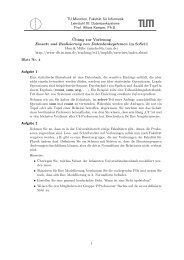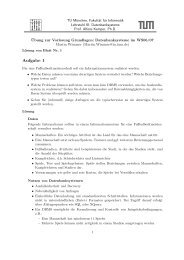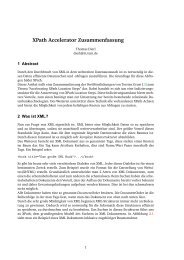The Adaptive Radix Tree: ARTful Indexing for Main-Memory ...
The Adaptive Radix Tree: ARTful Indexing for Main-Memory ...
The Adaptive Radix Tree: ARTful Indexing for Main-Memory ...
Create successful ePaper yourself
Turn your PDF publications into a flip-book with our unique Google optimized e-Paper software.
M lookups/second<br />
100<br />
75<br />
50<br />
25<br />
0<br />
ART<br />
HT<br />
FAST<br />
M lookups/second<br />
20<br />
15<br />
10<br />
5<br />
0<br />
HT<br />
ART<br />
FAST<br />
0.25 0.50 0.75 1.00 1.25<br />
Zipf parameter s (skew)<br />
192KB 384KB 768KB 1.5MB 3MB 6MB<br />
effective cache size (log scale)<br />
12MB<br />
Fig. 12.<br />
Impact of skew on search per<strong>for</strong>mance (16M keys).<br />
Fig. 13.<br />
Impact of cache size on search per<strong>for</strong>mance (16M keys).<br />
B. Caching Effects<br />
Let us now investigate caching effects. For modern CPUs,<br />
caches are extremely important, because DRAM latency<br />
amounts to hundreds of CPU cycles. <strong>Tree</strong> structures, in<br />
particular, benefit from caches very much because frequently<br />
accessed nodes and the top levels are usually cached. To<br />
quantify these caching effects, we compare two tree structures,<br />
ART (with dense keys) and FAST, to a hash table.<br />
Random lookup, which we per<strong>for</strong>med so far, is the worst<br />
case <strong>for</strong> caches because this access pattern has bad temporal<br />
locality. In practice, skewed access patterns are very common,<br />
e.g., recent orders are accessed more often than old orders.<br />
We simulated such a scenario by looking up Zipf distributed<br />
keys instead of random keys. Figure 12 shows the impact of<br />
increasing skew on the per<strong>for</strong>mance of the three data structures.<br />
All data structures per<strong>for</strong>m much better in the presence<br />
of skew because the number of cache misses decreases. As the<br />
skew increases, the per<strong>for</strong>mance of ART and the hash table<br />
approaches their speed in small, cache resident trees. For FAST<br />
the speedup is smaller because it requires more comparisons<br />
and offset calculations which are not improved by caching.<br />
We now turn our attention to the influence of the cache<br />
size. In the previous experiments, we only per<strong>for</strong>med lookups<br />
in a single tree. As a consequence, the entire cache was<br />
utilized, because there were no competing memory accesses.<br />
In practice, caches usually contain multiple indexes and other<br />
data. To simulate competing accesses and there<strong>for</strong>e effectively<br />
smaller caches, we look up keys in multiple data structures in<br />
a round-robin fashion. Each data structure stores 16M random,<br />
dense keys and occupies more than 128MB. Figure 13 shows<br />
that the hash table is mostly unaffected, as it does not use<br />
caches effectively anyway, while the per<strong>for</strong>mance of the trees<br />
improves with increasing cache size, because more oftentraversed<br />
paths are cached. With 1 64th of the cache (192KB),<br />
ART reaches only about one third of the per<strong>for</strong>mance of the<br />
entire cache (12MB).<br />
C. Updates<br />
Besides efficient search, an indexing structure must support<br />
efficient updates as well. Figure 14 shows the throughput when<br />
M inserts/second<br />
15<br />
10<br />
5<br />
0<br />
Fig. 14.<br />
ART<br />
ART<br />
(bulk)<br />
dense<br />
sparse<br />
GPT RB CSB<br />
(bulk)<br />
HT<br />
Insertion of 16M keys into an empty index structure.<br />
inserting 16M random keys into an empty structure. Although<br />
ART must dynamically replace its internal data structures<br />
as the tree grows, it is more efficient than the other data<br />
structures. <strong>The</strong> impact of adaptive nodes on the insertion per<strong>for</strong>mance<br />
(in comparison with only using Node256) is 20%<br />
<strong>for</strong> trees with 16M dense keys. Since the space savings from<br />
adaptive nodes can be large, this is usually a worthwhile trade<br />
off. In comparison with incremental insertion, bulk insertion<br />
increases per<strong>for</strong>mance by a factor of 2.5 <strong>for</strong> sparse keys and<br />
by 17% <strong>for</strong> dense keys. When sorted keys, e.g., surrogate<br />
primary keys, are inserted, the per<strong>for</strong>mance of ordered search<br />
trees increases because of caching effects. For ART, 50 million<br />
sorted, dense keys can be inserted per second. Only the hash<br />
table does not benefit from the sorted order because hashing<br />
randomizes the access pattern.<br />
FAST and the k-ary search tree are static data structures that<br />
can only be updated by rebuilding them, which is why they<br />
were not included in the previous experiment. One possibility<br />
<strong>for</strong> using read-only data structures in applications that require<br />
incremental updates is to use a delta mechanism: A second<br />
data structure, which supports online updates, stores differences<br />
and is periodically merged with the read-only structure.<br />
To evaluate the feasibility of this approach, we used a redblack<br />
tree to store the delta plus FAST as the main search<br />
structure, and compared it to ART (with dense keys) and a<br />
hash table. We used the optimal merging frequency between



